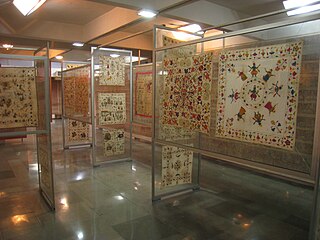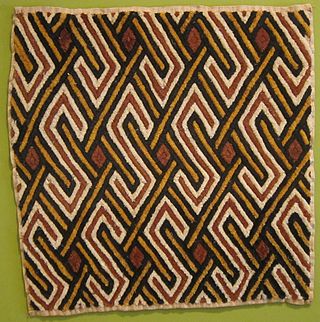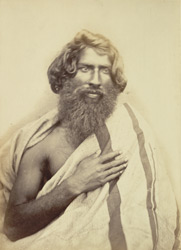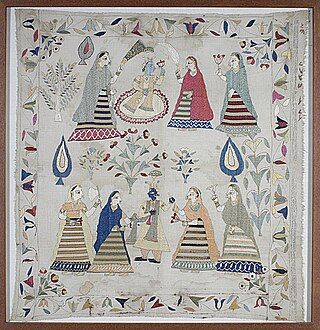Related Research Articles

Embroidery is the art of decorating fabric or other materials using a needle to stitch thread or yarn. Embroidery may also incorporate other materials such as pearls, beads, quills, and sequins. In modern days, embroidery is usually seen on hats, clothing, blankets, and handbags. Embroidery is available in a wide variety of thread or yarn colour. It is often used to personalize gifts or clothing items.

Hardanger embroidery or "Hardangersøm" is a form of embroidery traditionally worked with white thread on white even-weave linen or cloth, using counted thread and drawn thread work techniques. It is sometimes called whitework embroidery.

A quilt is a multi-layered textile, traditionally composed of two or more layers of fabric or fiber. Commonly three layers are used with a filler material. These layers traditionally include a woven cloth top, a layer of batting or wadding, and a woven back combined using the techniques of quilting. This is the process of sewing on the face of the fabric, and not just the edges, to combine the three layers together to reinforce the material. Stitching patterns can be a decorative element. A single piece of fabric can be used for the top of a quilt, but in many cases the top is created from smaller fabric pieces joined, or patchwork. The pattern and color of these pieces creates the design. Quilts may contain valuable historical information about their creators, "visualizing particular segments of history in tangible, textured ways".

Appliqué is ornamental needlework in which pieces or patches of fabric in different shapes and patterns are sewn or stuck onto a larger piece to form a picture or pattern. It is commonly used as decoration, especially on garments. The technique is accomplished either by hand stitching or machine. Appliqué is commonly practised with textiles, but the term may be applied to similar techniques used on different materials. In the context of ceramics, for example, an appliqué is a separate piece of clay added to the primary work, generally for the purpose of decoration.
Needlepoint is a type of canvas work, a form of embroidery in which yarn is stitched through a stiff open weave canvas. Traditionally needlepoint designs completely cover the canvas. Although needlepoint may be worked in a variety of stitches, many needlepoint designs use only a simple tent stitch and rely upon color changes in the yarn to construct the pattern. Needlepoint is the oldest form of canvas work.

Fiber art refers to fine art whose material consists of natural or synthetic fiber and other components, such as fabric or yarn. It focuses on the materials and on the manual labor on the part of the artist as part of the works' significance, and prioritizes aesthetic value over utility.

Korean embroidery techniques and artifacts have a long history, but there is the most evidence from the Joseon Dynasty, after the 14th century in Korea. This article talks about the history, styles, preservation, artists, and examples of screens, costumes, and domestic wares of this exacting and beautiful art form.

Phulkari refers to the folk embroidery of the Punjab region and Gulkari of Sindh in South Asia.

Embroidery in India includes dozens of embroidery styles that vary by region and clothing styles. Designs in Indian embroidery are formed on the basis of the texture and the design of the fabric and the stitch. The dot and the alternate dot, the circle, the square, the triangle, and permutations and combinations of these constitute the design.

African textiles are textiles from various locations across the African continent. Across Africa, there are many distinctive styles, techniques, dyeing methods, and decorative and functional purposes. These textiles hold cultural significance and also have significance as historical documents of African design.

Goldwork is the art of embroidery using metal threads. It is particularly prized for the way light plays on it. The term "goldwork" is used even when the threads are imitation gold, silver, or copper. The metal wires used to make the threads have never been entirely gold; they have always been gold-coated silver or cheaper metals, and even then the "gold" often contains a very low percent of real gold. Most metal threads are available in silver and sometimes copper as well as gold; some are available in colors as well.
Nava Lubelski is a contemporary artist who works and lives in Asheville, North Carolina.
Sermeh embroidery, also known as Sormeh embroidery, is an Iranian ancient-style of embroidery. Its origin dates back to the Achaemenid dynasty. It reached its zenith in the Safavid Dynasty. In this style of embroidery, gold and silver threads would be used to make decorating patterns on the surface of fabric; however, nowadays, almost entirely, threads twisted out of cheaper metals and alloys and metal like yarns have replaced gold and silver. The yarn used in patterning is springlike and elastic. Sermeh embroidery is the most popular in the cities of Isfahan, Yazd, Kashan.

Embroidery was an important art in the Islamic world from the beginning of Islam until the Industrial Revolution disrupted traditional ways of life.
Barbara Lee Smith is an American mixed media artist, writer, educator, and curator. She creates large scale landscapes and abstract works using a three step process of painting, collage, and machine stitching.

Toda embroidery, also locally known as "pukhoor", is an art work among the Toda pastoral people of Nilgiris, in Tamil Nadu, made exclusively by their women. The embroidery, which has a fine finish, appears like a woven cloth but is made with use of red and black threads with a white cotton cloth background. Both sides of the embroidered fabric are usable and the Toda people are proud of this heritage. Both men and women adorn themselves with the embroidered cloaks and shawls.

The Chamba Rumal or Chamba handkerchief is an embroidered handicraft that was once promoted under the patronage of the former rulers of Chamba kingdom. It is a common item of gift during marriages with detailed patterns in bright and pleasing colour schemes.
Orly Cogan is an Israeli-American fiber artist who works with and combines multiple mediums. She is best known for crafting hand stitched embroidered figures on top of previously embroidered vintage fabrics.
Hunan embroidery, or Xiang embroidery, as one of the traditional folk arts of China, together with Cantonese embroidery, Sichuan embroidery and Suzhou embroidery, is regarded as the four most distinguished embroidery styles in China. It is a general name for the embroidery products which rise from and are mostly produced at Changsha, Hunan, with distinct characteristics of Chu culture. Hunan embroidery is particularly famous in embroidering with silk thread, and the patterns have a high sense of reality. In 2006, Hunan embroidery was selected into the first batch of national intangible cultural heritage list.

Colcha embroidery from the southwest United States is a form of surface embroidery that uses wool threads on cotton or linen fabric. During the Spanish Colonial period, the word colcha referred to a densely embroidered wool coverlet. In time, the word also came to refer to the embroidery stitch that was used for these coverlets, and then began to be used on other surfaces. The colcha stitch is self-couched, with threads applied at a 45-degree angle to tie down the stitch. Originally, the wool threads were dyed naturally, using plants or insects, such as cochineal. Both materials used and design motifs have varied over time.
References
- 1 2 "Q&A with Rebecca Ringquist: A Narrative Fiber Artist". Archived from the original on February 23, 2012.
- ↑ Fiber and Material Studies, School of the Art Institute of Chicago
- ↑ "blog :: teacher feature: rebecca ringquist". www.squamartworkshops.com. Retrieved April 27, 2016.
- ↑ "BRIC Contemporary Artist Registry :: BRIC". registry.bricartsmedia.org. Retrieved May 2, 2016.
- ↑ "ArtStyle " Q&A with Rebecca Ringquist: A Narrative Fiber Artist". www.chicagoarts-lifestyle.com. Retrieved April 27, 2016.
- ↑ "BRIC Contemporary Artist Registry :: BRIC". registry.bricartsmedia.org. Retrieved April 30, 2016.
- 1 2 "ArtStyle " Q&A with Rebecca Ringquist: A Narrative Fiber Artist". www.chicagoarts-lifestyle.com. Retrieved April 30, 2016.
- ↑ "Hoop-la: Embroidery's back, with some modern twists | Brooklyn Daily Eagle". www.brooklyneagle.com. February 24, 2015. Retrieved April 27, 2016.
- 1 2 3 4 5 6 Ringquist, Rebecca (April 14, 2015). Rebecca Ringquist's Embroidery Workshops A Bend-the-Rules Primer. ISBN 9781617691416 . Retrieved May 2, 2016.
{{cite book}}:|website=ignored (help) - 1 2 3 "Hoop-la: Embroidery's back, with some modern twists | Brooklyn Daily Eagle". www.brooklyneagle.com. February 24, 2015. Retrieved May 2, 2016.
- 1 2 3 4 "ArtStyle " Q&A with Rebecca Ringquist: A Narrative Fiber Artist". www.chicagoarts-lifestyle.com. Retrieved May 2, 2016.